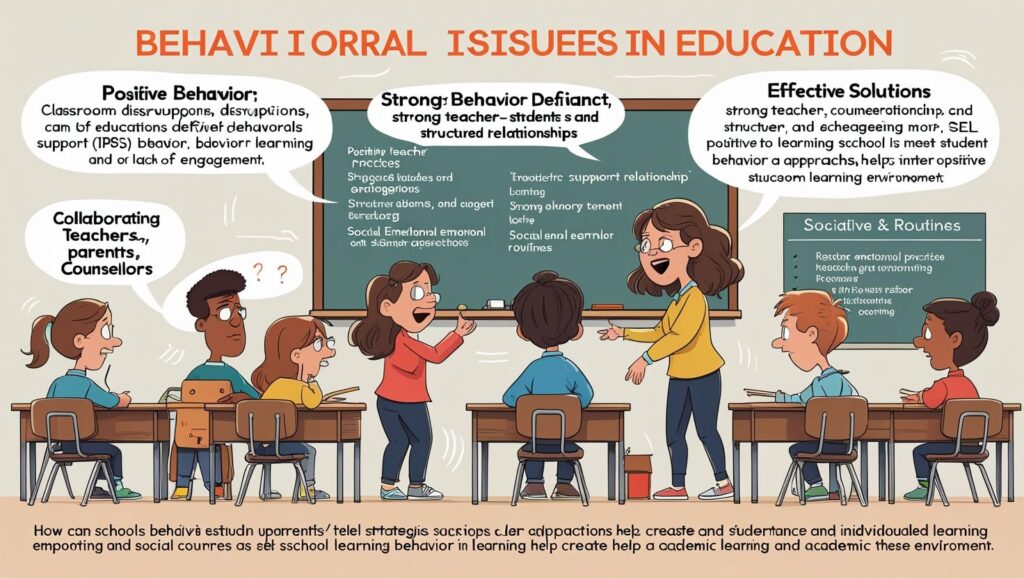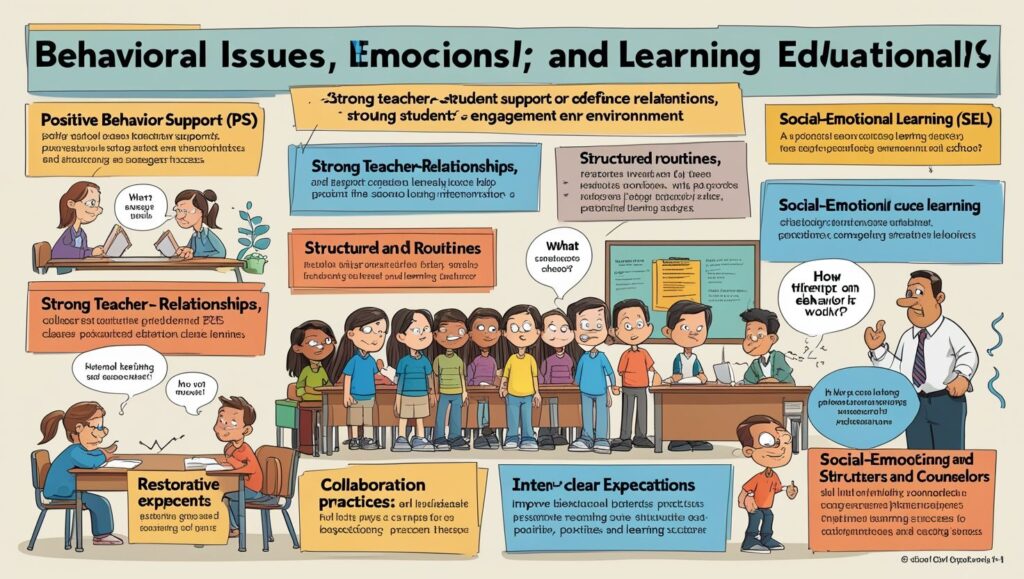Introduction
Solving Behavioral Issues in Education, Behavioral issues in education are a significant challenge for teachers, parents, and students alike. Disruptive behavior, lack of motivation, aggression, and attention deficits can hinder learning and create a negative classroom environment. Addressing these issues requires a combination of proactive strategies, empathy, and structured interventions.
This article explores the root causes of behavioral problems in students, effective strategies for managing them, and the role of teachers, parents, and school administrators in fostering positive behavior. By implementing evidence-based approaches, educators can create a more conducive learning environment that supports both academic and social-emotional development.
Understanding the Causes of Behavioral Issues
Before addressing behavioral problems, it is essential to understand their underlying causes. Some common factors include:
1. Environmental Factors
- Home Environment: Family conflicts, neglect, or inconsistent discipline can lead to behavioral issues in school.
- Peer Influence: Bullying, peer pressure, and social dynamics can affect a student’s behavior.
- School Climate: Overcrowded classrooms, lack of engagement, or poor teacher-student relationships can contribute to misconduct.
2. Psychological and Emotional Factors
- Mental Health Issues: Anxiety, depression, ADHD, and trauma can manifest as behavioral problems.
- Low Self-Esteem: Students who struggle academically or socially may act out to gain attention.
- Frustration with Learning Difficulties: Undiagnosed learning disabilities can lead to disruptive behavior.
3. Developmental and Neurological Factors
- ADHD & Autism Spectrum Disorders: These conditions can affect impulse control and social interactions.
- Cognitive Delays: Students with developmental delays may struggle with following rules or understanding consequences.
4. Lack of Structure and Clear Expectations
- Inconsistent discipline, unclear rules, and lack of routines can lead to confusion and misbehavior.

Effective Strategies for Managing Behavioral Issues
1. Positive Behavior Support (PBS)
PBS is a proactive approach that focuses on reinforcing positive behavior rather than punishing negative actions. Key components include:
- Setting Clear Expectations: Clearly defined rules and routines help students understand behavioral standards.
- Positive Reinforcement: Rewarding good behavior (e.g., praise, tokens, privileges) encourages repetition.
- Behavioral Interventions: Individualized plans for students with chronic issues.
2. Building Strong Teacher-Student Relationships
- Show Empathy and Understanding: Students are more likely to cooperate when they feel respected.
- Active Listening: Addressing underlying concerns (e.g., academic struggles, personal issues) can reduce defiance.
- Mentorship Programs: Pairing at-risk students with supportive teachers or older peers can improve behavior.
3. Classroom Management Techniques
- Structured Routines: Predictable schedules reduce anxiety and prevent disruptions.
- Engaging Lessons: Interactive and hands-on activities keep students focused.
- Proximity Control: Standing near disruptive students can deter misbehavior without confrontation.
- Non-Verbal Cues: Eye contact, gestures, or a gentle tap on the desk can redirect attention.
4. Social-Emotional Learning (SEL) Programs
SEL teaches students skills like self-regulation, empathy, and conflict resolution. Benefits include:
- Improved emotional control
- Better peer relationships
- Reduced aggression and impulsivity
5. Restorative Practices
Instead of punitive measures, restorative approaches focus on repairing harm and rebuilding relationships. Techniques include:
- Restorative Circles: Group discussions to resolve conflicts.
- Peer Mediation: Students help each other find solutions.
- Apology Letters & Accountability: Encouraging students to take responsibility for their actions.

6. Collaboration with Parents and Specialists
- Parent-Teacher Meetings: Regular communication ensures consistency between home and school.
- Counseling & Therapy: School psychologists or behavioral therapists can assist with severe cases.
- Individualized Education Plans (IEPs): Customized strategies for students with disabilities.
Role of Teachers in Addressing Behavioral Issues
Teachers play a crucial role in shaping student behavior. Effective strategies include:
- Modeling Respect and Patience: Demonstrating calm and respectful behavior sets a positive example.
- Differentiated Instruction: Adapting lessons to different learning styles prevents frustration.
- Consistent Consequences: Fair and predictable responses to misbehavior reinforce discipline.
Role of Parents in Supporting Positive Behavior
Parents can reinforce good behavior by:
- Establishing Routines at Home: Consistent schedules improve self-discipline.
- Encouraging Open Communication: Discussing school experiences helps identify issues early.
- Providing Emotional Support: A stable home environment reduces stress and acting out.
School-Wide Policies for Behavioral Management
Administrators should implement:
- Anti-Bullying Programs: Creating a safe and inclusive environment.
- Professional Development for Teachers: Training in behavioral management techniques.
- Behavioral Support Teams: Specialists who assist with challenging cases.
Conclusion
Behavioral issues in education require a multi-faceted approach involving teachers, parents, and school systems. By understanding root causes, implementing positive reinforcement strategies, and fostering strong relationships, educators can create a supportive environment where students thrive academically and socially.
Investing in social-emotional learning, restorative practices, and individualized support ensures that every student has the opportunity to succeed. With patience, consistency, and collaboration, behavioral challenges can be effectively managed, leading to a more productive and harmonious classroom experience for all.

5 thoughts on “Solving Behavioral Issues in Education”
Comments are closed.